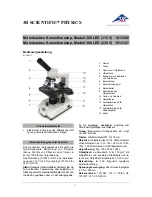
3
make the sample look very big. This microscope can make things look 300 times, 600 times, or even
1,200 times bigger than you can see them with your own eyes.
b)
Scalpel
–
A scalpel is a sharp blade that is used to cut very thin pieces of material so you can look
at them with your microscope.
c)
Spatula
–
The spatula has a large flat blade, but it is not as sharp as the scalpel. It is used for
scraping off bits of material for testing and to push down on soft samples to mash them flat.
d)
Tweezers
–
The tweezers are like little pinchers. They are used to pick up small samples and to
handle samples that you don’t want to touch with your hands – like slimy mold!
e)
Collecting vials
–
These are little plastic bottles with tight-fitting lids. They are used to carry your
samples from the place you collected them to the place you have your microscope set up.
f)
Test tube with cap
–
This thin, clear tube is used to hold liquid samples when you want to see if
anything is happening, like when a sample changes color.
g)
Petri dish
–
This is a round, flat dish with a clear cover. It is used to grow and observe samples
such as molds.
h)
Pipette
–
This is a soft plastic tube with a squeeze bulb on one end that you use to transfer a drop
or two of liquid to a slide for examination.
i)
Prepared slides
–
These are slides with professionally prepared samples on them for you to
examine.
j)
Blank slides
–
These are clear slides for you to use in preparing your own subjects for
examination.
k)
Slide labels
–
These are little pieces of paper with sticky backs. You can stick them on your slides
and record information, such as the name of the sample, or when the sample was prepared.
l)
Slide covers
–
These are little circles or squares made of thin, clear plastic. They are used to cover
very small samples on a slide. When they are clean and dry they stick to the glass slide with a static
electricity charge.
m)
Crystallized red dye
and
crystallized blue dye
–
In your set you will find two small plastic
bottles. One has a small amount of red powder in it and one has a small amount of blue powder. Add
enough warm water to half fill these plastic bottles. Place the lids on and make sure they are tight.
Shake well to make a supply of dye. If you add a drop of red or blue dye to a sample, like a thin slice
of onion, you will be able to see the cells much more clearly.
n)
Stirring rod
–
Use this rod to mix liquids until they are well blended. An example is when you mix
salt in water.
o)
Magnifying glass
–
This is useful for taking a close look at a sample before you examine it under
the high-power magnification of your microscope.
p)
Measuring graduate
–
This plastic cup is marked with measuring lines so that you can accurately
measure quantities of liquids in your experiments.





















